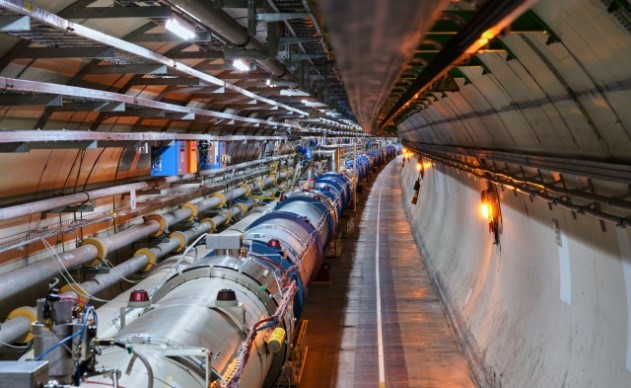Free Courses Sale ends Soon, Get It Now


Free Courses Sale ends Soon, Get It Now



Disclaimer: Copyright infringement not intended.
Context
LHC
About
|
HADRON The term hadron refers to subatomic composite particles composed of quarks held together by a strong force (analogous to the way that atoms and molecules are held together by electromagnetic force). The best-known hadrons are the baryons such as protons and neutrons; hadrons also include mesons such as the pion and kaon, which were discovered during cosmic ray experiments in the late 1940s and early 1950s. |
Built by
Collaboration
Location
Goal
Working
A collider is a type of particle accelerator that brings two opposing particle beams together such that the particles collide. In particle physics, colliders, though harder to construct, are a powerful research tool because they reach a much higher center of mass energy than fixed target setups. Analysis of the byproducts of these collisions gives scientists good evidence of the structure of the subatomic world and the laws of nature governing it. Many of these byproducts are produced only by high-energy collisions, and they decay after very short periods of time.
Findings of LHC
Way Forward
New Physics is the collective name for particles or processes that can explain the nature of dark matter or why gravity is such a weak force, among other mysteries.
|
HIGGS BOSON The Higgs boson is the fundamental force-carrying particle of the Higgs field, which is responsible for granting other particles their mass. The Higgs boson has a mass of 125 billion electron volts — meaning it is 130 times more massive than a proton. It is also chargeless with zero spin — a quantum mechanical equivalent to angular momentum. The Higgs Boson is the only elementary particle with no spin.
|
READ:
STANDARD MODEL OF PHYSICS: https://www.iasgyan.in/daily-current-affairs/w-boson
|
PRACTICE QUESTION Q. Which of the following statements are correct? a) Higgs boson has a mass of 125 billion electron volts — meaning it is 130 times more massive than a proton. b) The Higgs Boson is the only elementary particle with no spin. c) The term hadron refers to subatomic composite particles composed of quarks held together by a strong force. d) Bosons are sometimes called force particles, because it is the bosons that control the interaction of physical forces, such as electromagnetism. 1. a and c only 2. b and d only 3. c and d only. 4. All of the above statements are correct. Correct Answer: Option 4 |
https://www.thehindu.com/sci-tech/science/explained-a-beginners-guide-to-the-large-hadron-collider/article66724349.ece
© 2024 iasgyan. All right reserved